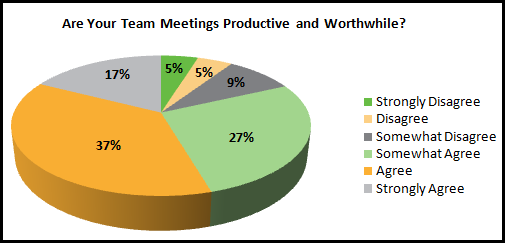We can all agree there are good meetings and there are bad meetings, and there are even meetings about meetings…
All joking aside, in order for your business to be successful it is critical that team meetings are meaningful and productive for all members of the team. And the responsibility for making sure meetings are well-managed is one of the most important aspects of being a great leader.
After studying five years’ worth of survey responses, the data clearly shows the impact team meetings have on employees.
Team Meetings At A Glance:
- When 141 survey participants were asked if their company held effective team meetings, 66% answered affirmatively while 34% of the responses were negative – stating their company team meetings were not effective.
- Similarly, when 750 survey participants were asked, “Are your team meetings productive and worthwhile?” 81% responded affirmatively by selecting “Strongly Agree,” “Agree,” or “Somewhat Agree” and 19% responded negatively by selecting “Strongly Disagree,” “Disagree,” or “Somewhat Disagree.”
IN A NUTSHELL: While the majority of employees surveyed said their team meetings were effective, productive, and worthwhile, nearly 20% described their team meetings negatively, calling them ineffective, not productive, and not worthwhile.
So, how does a well-planned, organized, and executed team meeting directly influence a team’s success? Positive information sharing, good communication, and teamwork, all aspects of a well-planned, organized, and executed team meeting, increase a team’s morale, their satisfaction, and productivity.
When developing and planning for effective team meetings, we recommend following these three simple rules to achieve success and growth:
1. Establish the Purpose (the WHY)
When participants understand the meeting’s purpose, they will come prepared to make a meaningful contribution. Advance materials must set out the objective in a straightforward way, and that objective should be reinforced throughout the meeting, too. “Winging it” or “shooting from the hip” is just too risky. Think about what you want the outcome of the meeting to be – an example of this might be for everyone to be aligned on next month’s goals and critical moves. Once you’ve decided on the outcome or purpose of the meeting develop a brief but informative agenda and share that with your team twenty-four hours in advance. This not only gives them time to prepare for the meeting themselves, but also shows that you’ve taken the initiative and time to plan on your end. When you send the agenda it is also your opportunity to convey what the purpose is, be transparent and let your team know why you’ve chosen each specific agenda item and what the outcomes for each should be.
2. Be Disciplined and Manage the Time
Ever heard the old saying that people age at twice the normal rate in business meetings? That’s because meeting facilitators don’t always structure the sessions wisely. Help participants maintain their focus and keep things moving along by sticking to your established agenda. While you should encourage participation and interaction, it is important that you keep the team on track in regards to your agenda and the purpose of the meeting. Many teams find themselves off topic, thus wasting valuable meeting time. As a leader you must interject and move the team back to the objectives. A good way to set this standard from the beginning of the meeting is to ask your team what they want to get out of the meeting. If these requests are outside of the planned agenda, take those conversations “offline” and continue forward with the planned meeting. This will help your team feel as though they have a voice. It’s also important for you to extrapolate participation by asking great questions.
3. Establish Buy-in and Collaboration
Participants who have ownership of the meeting’s topic and outcomes are more likely to help find solutions. People need to be heard. They need to know that their opinions matter. Leaders who understand these simple truths will meet their objectives more often than not. Additionally, -in some cases, a meeting without a re-cap isn’t a meeting at all…or at least not a great one. In order to ensure your team is on the same page regarding the objectives, make sure you leave the meeting with solid and clear action items. Also, be sure to follow up on these action items after the meeting.
At eQ, we know all the tricks when it comes to planning and running great team meetings. If you’re interested in learning more, contact us today!
Joe Mechlinski is the President of entreQuest and has partnered with countless leaders to effectively improve their team’s performance, their clients’ experience, and their company’s profits.








